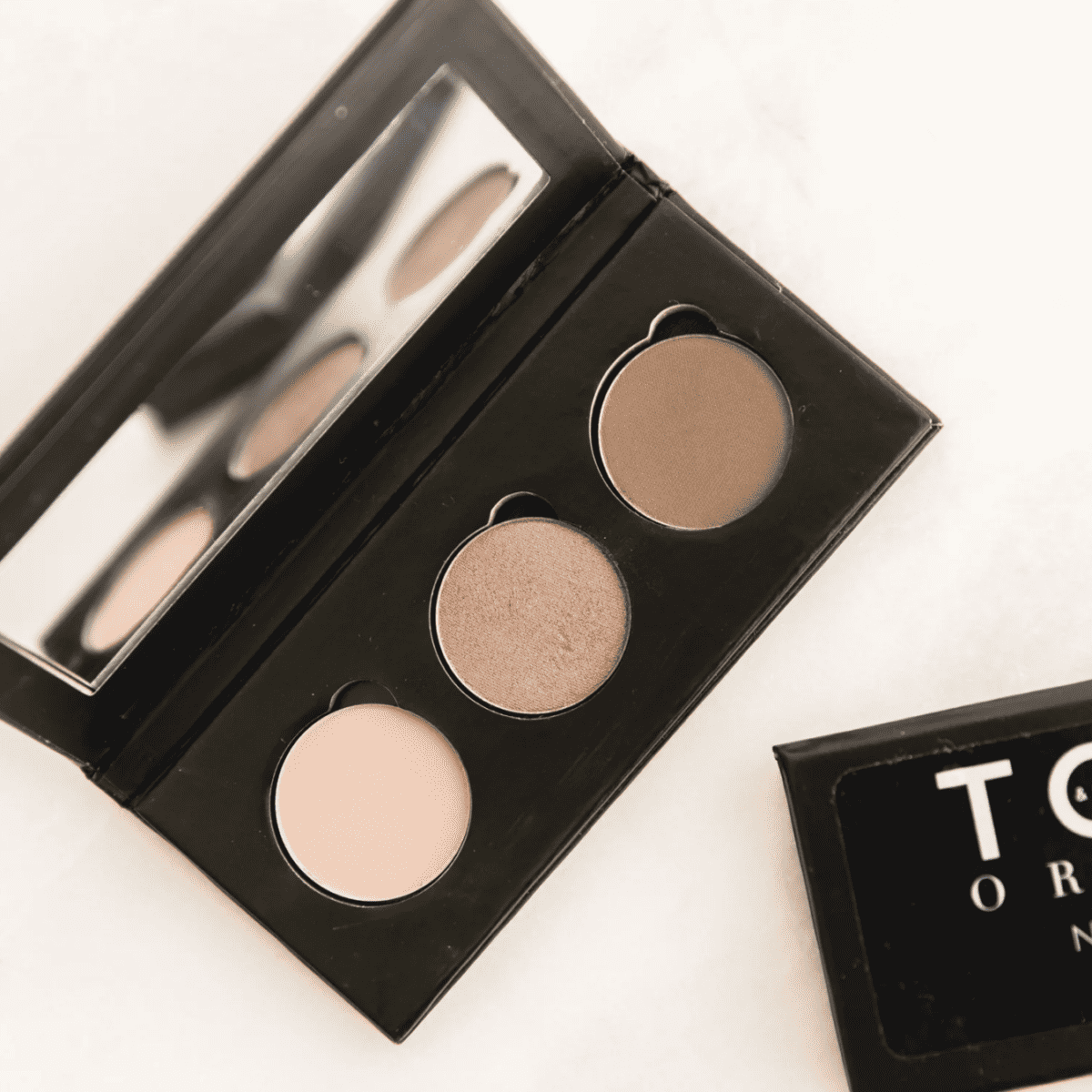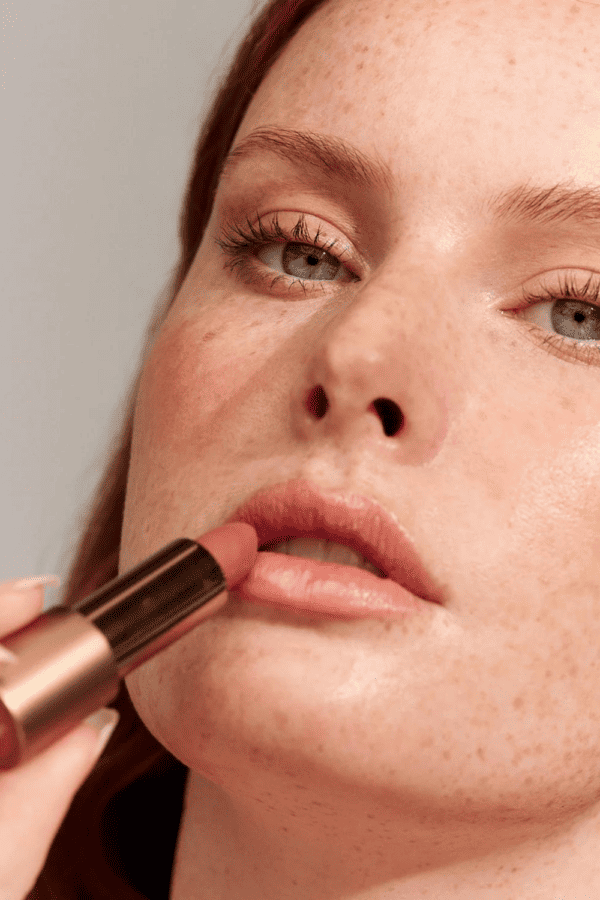In a Nutshell:
- Talc is a naturally-occurring mineral that is often used in powders, including baby powder and powdered makeup (like eyeshadow!).
- Talc itself is not problematic, but it’s often contaminated with asbestos, which is a carcinogen.
- My top brands for talc-free eyeshadow include:
- Scroll down for even more options! 👇
When browsing eyeshadow options, the criteria list often includes the following: long-lasting, pigmented, blendable… You get the gist. But have you considered adding talc-free to your list of non-negotiables?
Many eyeshadows (along with other makeup products like foundation and lipstick) contain talc. While talc in itself is not harmful, it’s often contaminated with asbestos. Asbestos is carcinogenic and it’s unsafe to breathe in or apply to your skin.
If non-toxic beauty products are important to you, then it’s essential to kick talc out of your makeup bag. Today, I’m diving into my favorite non-toxic and talc-free eyeshadows so you can wear a worry-free smokey eye!
Table of Contents
- What is Talc?
- Is Talc Toxic?
- Other Ingredients to Avoid in Eyeshadow
- Butylated Compounds
- Carbon Black
- Ethanolamines (DEA, MEA, TEA)
- Fragrance
- Formaldehyde or Formaldehyde Releasers
- Mineral Oil
- Parabens
- Petroleum
- Phthalates
- Polytetrafluoroethylene (PTFE, aka PFAS)
- What About Titanium Dioxide?
- The Best Talc-Free Eyeshadow
This article contains affiliate links, which means we may earn commission if you decide to make a purchase.
Featured image credit: INIKA
What is Talc?
Talc is a naturally occurring mineral made up of magnesium, oxygen, silicon, and hydrogen. It’s often found in makeup and beauty products due to its anti-caking and moisture-absorbing properties as well as its soft texture.
Talc is commonly used in powder formulas like eyeshadow, blush, baby powder, and dry shampoo.
Is Talc Toxic?
As I mentioned, talc itself is not toxic. However, because of the fact that it’s mined from the earth and is often found right next to asbestos desposits, talc often contains asbetos.
Unless manufacturers actually test their products regularly for asbestos, there’s no way to really know if they contain asbestos fibers or not.
Talc has been raising red flags since the 1960s because of its connection to ovarian cancer. To this day, Johnson & Johnson is still fighting lawsuits from plaintiffs who say using their powders gave them cancer. (Due to consumer outcry, J&J finally stopped selling talc-based baby powder in 2023… decades after the cancer association was made.)
Yet, talc still makes its way into our eyeshadows and other everyday powders which we apply to our skin. It can even sometimes be found in foods like rice or chewing gum!
Since talc is seemingly abundant in the marketplace, you’ll have to take it upon yourself to actively avoid this toxic ingredient. If a formula has talc, talcum powder, or magnesium silicate, it’s best to stay away to protect your health.
Does Asbestos-Free Talc Exist?
Yes, asbestos-free talc does exist. However, the only way to determine whether or not talc is asbestos-free is through testing.
Some companies sell products that are tested and certified asbestos-free. However, there have been some murky results when these claims were put to the test. For example, tremolite, a type of asbestos, was found in talcum powders that were marketed as “tremolite-free”.
That’s why I recommend making it easier for yourself and just avoiding talc altogether if you can.
The good news is that there are plenty of talc-free options on the market to eliminate the worry of potential asbestos contamination!
Other Ingredients to Avoid in Eyeshadow
Along with talc, you may have heard of toxic ingredients like parabens, phthalates, or fragrances. Keep an eye out for these other ingredients to avoid putting them on your skin:
Butylated Compounds
Butylated hydroxytoluene (BHT) and butylated hydroxyanisole (BHA) are synthetic antioxidants commonly used as preservatives in makeup formulas. BHT is a toxicant that has been linked to cancer. In addition to the negative health impacts, BHT is a toluene-based ingredient. Toluene is a toxin that can potentially cause health implications like neurological damage.
Carbon Black
Known for creating rich, dark pigments in cosmetics like mascara and eyeshadow, carbon black has been linked to cancer and should be avoided. But don’t worry; there are other (safer) ways to achieve dark makeup shades!
Ethanolamines (DEA, MEA, TEA)
Ethanolamines like diethanolamine (DEA), monoethanolamine (MEA), and triethanolamine (TEA) are toxic, and DEA and TEA are linked to cancer. Additionally, DEA can turn into a carcinogen called nitrosodiethanolamine (NDEA) when mixed with other ingredients.
Fragrance
Although fragrance may not be the first ingredient that comes to mind for eyeshadow, many palettes are scented with undisclosed ingredients to convey a theme (like desserts, fruits, etc.). The problem is that companies aren’t required to share what they put in synthetic fragrances and often take it as an opportunity to use harmful allergens or toxins, such as phthalates.
Formaldehyde or Formaldehyde Releasers
It’s no secret that formaldehyde is carcinogenic. It’s not as common as it used to be in makeup and skincare (although it still gets used sometimes), but formaldehyde-releasers can be found in many products.
Formaldehyde releasers include chemicals like DMDM hydantoin, quaternium-15, sodium hydroxymethylglycinate, bromopol, diazolidinyl urea, polyoxymethylene urea, and imidazolidinyl urea. These ingredients are called formaldehyde “releasers” because they emit low levels of formaldehyde over time. Formaldehyde exposure has been linked to increased risks of miscarriages and impacted fertility.
Mineral Oil
Mineral oils (like petrolatums, synthetic wax, and paraffin) can be found in makeup and beauty products as binders. Although commonly used, these chemicals have been linked to cancer. It’s important to note that the risks associated with this ingredient depend on how they’ve been processed. However, there are so many great makeup products without mineral oil that it’s often not worth the risk.
Parabens
Parabens (like methylparaben, ethylparaben, propylparaben, and butylparaben) are potential endocrine disruptors commonly used as preservatives in makeup. Parabens have been linked to abnormal fetal development, depression, diminished ovarian reserve, and breast cancer and tumors.
Petroleum
Petroleum is a carcinogen often used in makeup and beauty products to maintain moisture. Petroleum can be spotted by looking to see if a product contains PEGs, ethanolamines, parabens, mineral oil, paraffin wax, toluene, benzene, butanol, methanol, and any word containing “butyl” or “propyl”.
Phthalates
Phthalates are endocrine disruptors often found in “fragrance”. They’re linked to breast cancer, fertility issues, impacted childhood development, and pregnancy complications.
Polytetrafluoroethylene (PTFE, aka PFAS)
Believe it or not, an ingredient used in Teflon can make its way into our beauty products! PTFE is a type of PFAS known for its non-stick properties in cookware and can be found in makeup like eyeshadow, mascara, and blush. PFAS have been linked to developmental neurotoxicity, impacted reproductive function, and cancer.
What About Titanium Dioxide?
If you’ve been on the non-toxic lifestyle journey for a while, then you may know that whether or not titanium dioxide may be toxic depends on a couple of things.
The International Agency for Research on Cancer (IARC) considers titanium dioxide a “possible carcinogen” when it’s in its inhalable form.
It also depends on the size of the particles. For example, some evidence suggests that nanoparticles may be more threatening than non-nanoparticles. We need more research in this area.
Here’s the thing about eyeshadow… There’s not really such a thing as a powdered eyeshadow that is titanium-dioxide-free. Because eye shadows contain mined minerals such as mica and silica, there’s always a chance that they may contain titanium dioxide. That’s why, even if a brand doesn’t add titanium dioxide on purpose, you’ll still see something that looks like this on the ingredient list: “May Contain +/- : Titanium Dioxide.”
This isn’t a huge worry of mine when it comes to using pressed powders, but I would just recommend not inhaling the powder from your eyeshadow as you apply it (especially if your palette breaks and starts becoming more of a “loose” powder).
The Best Talc-Free Eyeshadow
Now that we’ve established what talc is and what other ingredients to avoid in your regimen, here are some of the best non-toxic (talc-free) eyeshadow options from brands like Beautycounter, Honest Beauty, and more!
Beautycounter Essentials Eye Palette


Price: $45
These talc-free eyeshadows include five warm matte and shimmery neutral shades. Made with lauroyl lysine, a conditioning agent from coconut fatty acids, these high-quality shadows have a silky butter texture to effortlessly blend and build your look. Created to flatter a wide range of skin tones and any eye color, this travel-friendly palette is made without any animal testing or toxic ingredients. The colors deliver rich pigment without any fading, creasing, or chalky texture.
Toups & Co.


Price: $14 (per single) – $38 (for a full palette)
This eyeshadow is free from all synthetics—it’s all-natural! A lot of the ingredients they use are organic, too.
The first time you buy from them, you can grab a 3-color palette, which is reusable. Then, you can refill it with the eyeshadow singles. That way, you can also create your own customized palette, choosing from 16 different colors.
Toups & Co. is a small, family-owned business that’s based in Alabama (where their organic makeup is handcrafted!). They source ingredients from small, local, and organic farms as much as possible.
Honest Beauty Get It Together Eyeshadow Palette


Price: $27
This blend of mattes and shimmers is the perfect starting point for any occasion. With classic shades of brown and fun metallic shades, these velvety powders are made without animal testing or toxins. This talc-free, richly pigmented, easily blendable palette from Honest Beauty has a versatile mix of colors that can be worn from day to night without creasing or wearing off.
INIKA Organic Quad Eyeshadow Palettes


Price: $49
The INIKA Quad palettes come in three shade ranges of matte and metallic finishes: Flowers for shimmery pinks and browns, Sunset for warm-toned browns and orange, and Wind for a cool-toned taupe look. These shadows are rich in pigment and perfect for creating versatile looks. Made with nourishing ingredients like cocoa seed extract and carnauba wax, these mineral pigments are long-wearing and eye-catching to enhance your natural beauty.
Jones Road “The Best” Eyeshadow


Price: $25
Although most of the shadows on this list are palettes, these talc-free colors from Jane Iredale couldn’t be excluded from the list of the best. Made with clean ingredients, there are 15 trendy shades from matte to metallic with an intense pigment. These powders are velvety, rich, soft, and buildable. A recipient of 2022’s Glamour Beauty Award, these clean shadows are a great option if you’re looking for a new everyday go-to shade.
Crunchi Shadow Bar Eyeshadow Palettes

Price: $48
These vegan palettes come in matte and shimmer colors in two shades: Spiced, a warm range of oranges and browns, and Enchanted Neutrals, which are more pink-based. Winner of the 2021 Healing Lifestyles Earth Day Beauty Awards, these eyeshadows are made without animal testing from ethically sourced mica for ultra-rich, blendable pigments. Made with nourishing ingredients like organic olive and jojoba oils, these eyeshadows hydrate the skin for long-wearing looks without creasing or fallout.
I hope this article has saved you time and energy, and that you were able to find a talc-free eyeshadow palette that you love!
If you’d like to get more non-toxic tips, news, and more delivered to your inbox once a week, sign up for Filtered Fridays! 🍋




